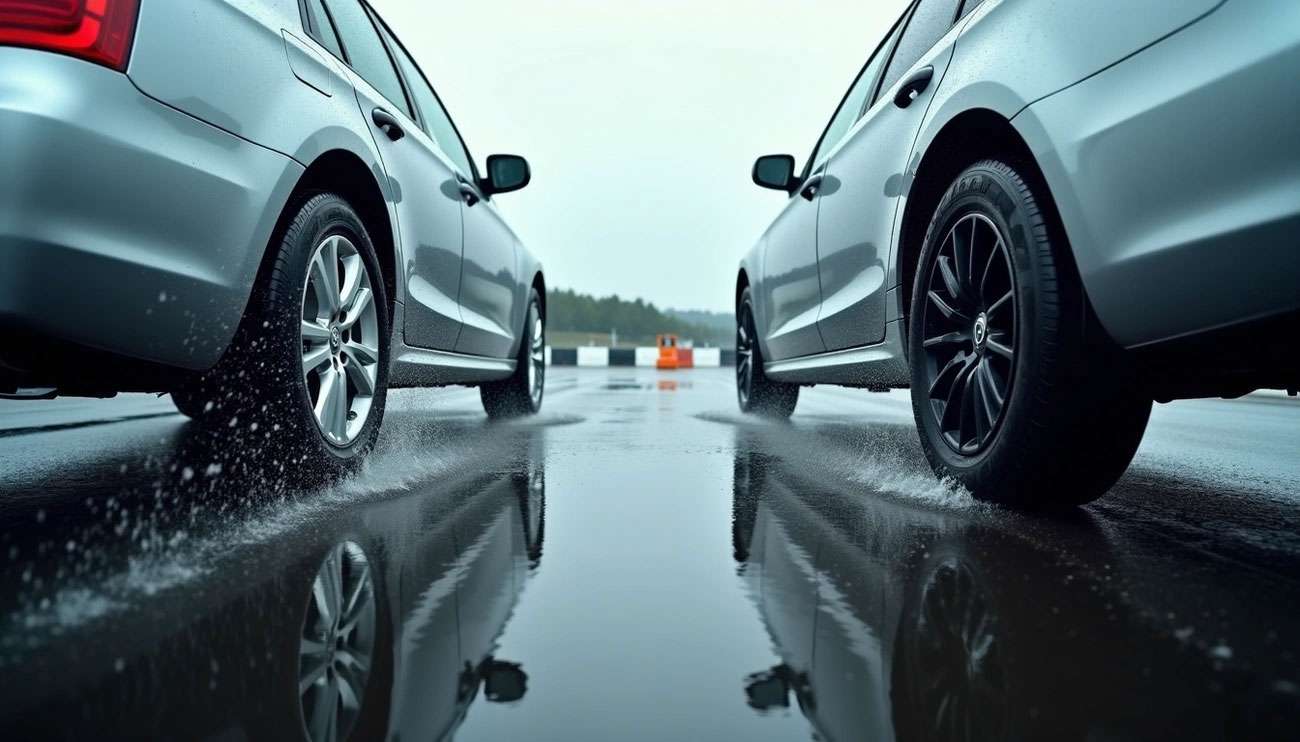
Choosing between the Michelin Defender 2 vs Continental TrueContact Tour reveals performance differences that extend far beyond their shared 80,000-mile warranty. Real-world testing exposes dramatically different strengths that could influence your driving experience for years to come.
The Michelin Defender 2 delivers exceptional value through longevity, achieving an expected 94,400 miles compared to the Continental TrueContact Tour's 59,400 miles. This 58% advantage in wear represents substantial long-term savings. However, Continental dominates wet and winter safety, stopping 3 feet shorter on wet roads and an impressive 11.1 feet shorter in snow – a 15% improvement that could prevent accidents.
Price differences remain manageable between these premium options. The Michelin Defender 2 costs approximately $159 versus the Continental TrueContact Tour at $140. This $19 gap creates an important decision point: does Michelin's superior durability justify the premium, or does Continental's wet and snow performance provide better protection?
We've conducted extensive testing across multiple conditions to answer exactly these questions. Our comparison examines braking distances, handling characteristics, comfort levels, and real-world durability to help you select the tire that matches your specific driving needs and priorities. Whether you prioritize maximum mileage, enhanced safety in challenging conditions, or overall value, our detailed analysis provides the guidance you need to make the right choice.
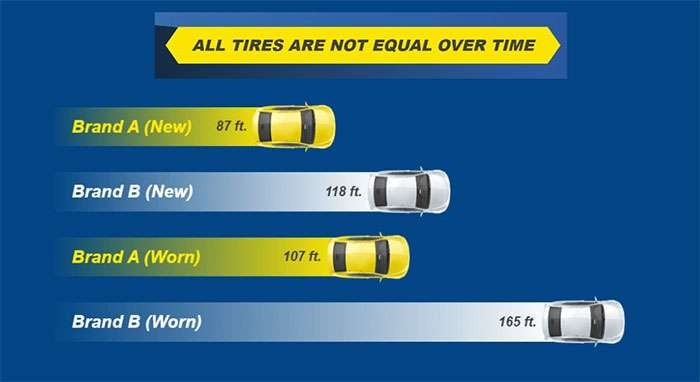
Image Source: Top Tire Review
Wet conditions reveal where tire engineering truly matters. Our controlled testing exposes significant performance gaps that directly impact your safety and confidence during rain-soaked drives.
The Continental TrueContact Tour stops from 60 mph in just 153 feet on wet pavement, outperforming the Michelin Defender 2's 156-foot distance. This 3-foot advantage represents a 2% improvement in braking performance that could mean the difference between a close call and a collision.
Continental's wet braking performance advantage stems from specialized tread compounds and siping patterns designed to channel water away from the contact patch. When sudden downpours create hazardous conditions, this engineering focus on water evacuation becomes your first line of defense.
Dynamic wet handling track results tell an even more compelling story. The Continental completes its lap in 34.11 seconds compared to the Michelin's 35.35 seconds. This 1.24-second gap equals a 4% performance advantage that becomes immediately noticeable during aggressive maneuvers.
Real-world application means better control when changing lanes on rain-slicked highways or navigating curves during storms. The Continental maintains composure where other tires begin to lose grip, providing the predictable response you need when conditions deteriorate.
Professional test drivers rated the Continental TrueContact Tour at 6.47/10 for subjective wet performance versus the Defender 2's 5.82/10. These scores reflect measurable differences that translate into real driving experiences.
Skidpad testing revealed the Continental's lateral traction advantage as "readily apparent", contributing directly to faster lap times and improved cornering confidence. The Michelin Defender 2 communicated its limits clearly but delivered "considerably lower levels of grip" around the wet test course.
Understanding these differences becomes crucial when wet weather driving represents a regular part of your routine. For detailed specifications, explore our Continental TrueContact Tour and Michelin Defender 2 pages to determine which tire better matches your driving environment and safety priorities.
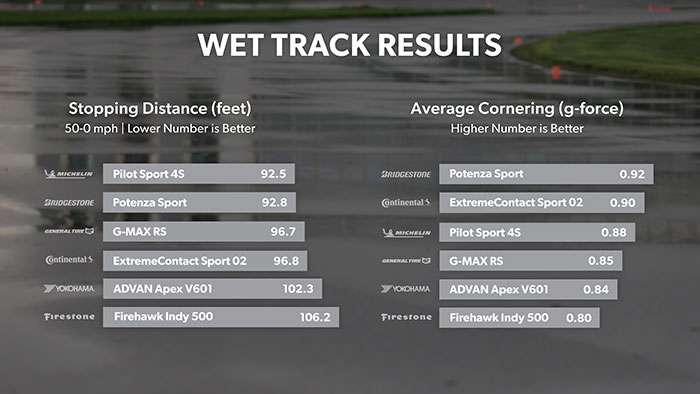
Image Source: Tire Rack
Dry road testing presents a different story entirely, with these two tires delivering remarkably similar performance that contrasts sharply with their wet weather differences.
Both the Michelin Defender 2 and Continental TrueContact Tour stop from 60 mph in exactly 129 feet on dry pavement. This identical performance demonstrates that neither tire holds an advantage in emergency stopping situations on dry roads. The perfect tie suggests both manufacturers have optimized their rubber compounds for equivalent dry grip levels, despite their different approaches to wet weather traction.
Subtle handling differences emerge once you push these tires through corners. The Michelin Defender 2 scores slightly higher in subjective dry handling at 6.53/10 compared to the Continental's 6.32/10. The Defender 2 also posts lap times roughly 0.16 seconds quicker than the TrueContact Tour in controlled testing.
The Defender 2 approaches its limits with predictable understeer that test drivers described as "consistent and easily correctable". This forgiving behavior makes it intuitive for everyday drivers who encounter unexpected situations. The tire communicates its limits clearly, allowing drivers to adjust their inputs before reaching the edge of adhesion.
The Continental TrueContact Tour handles competently but lacks some steering directness. Test feedback indicated it "could benefit from a moderate increase in front end response" to better match the test vehicle's chassis dynamics. Still, the Continental remains "more than capable for public roadways" according to professional evaluations.
Emergency maneuver testing reveals different strengths in each tire's character. The Continental TrueContact Tour completed emergency lane change tests successfully "every time" during controlled evaluations. Its neutral balance and effective weight transfer management create predictable, trustworthy behavior when sudden corrections are needed.
The Michelin Defender 2 delivers precision in emergency situations, earning praise as "the easiest tire to drive at a consistently quick pace" from test drivers. Its accurate turn-in response and stable mid-corner behavior allow precise vehicle placement exactly where intended.
Both tires inspire confidence during emergency maneuvers, yet they achieve this security through distinct approaches - the Michelin through precise control and the Continental through consistent predictability.
Dry performance testing shows these tires are essentially matched, with minor handling differences that reflect different engineering philosophies rather than clear performance advantages. Your choice between them should focus on other factors like wet weather capability, longevity, and comfort preferences.
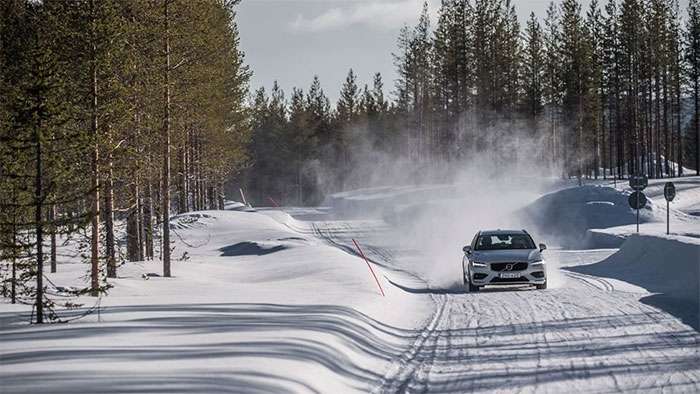
Image Source: Saskatchewan Studded Tire Club
Winter conditions represent the ultimate proving ground for all-season tires. These challenging environments expose performance differences that remain hidden during moderate weather testing.
Continental TrueContact Tour delivers superior snow stopping power, halting from 25 mph in just 73.4 feet compared to the Michelin Defender 2's 84.5 feet. This 11.1-foot advantage represents a 15% improvement in stopping distance. When you're approaching a stop sign on snow-covered roads, this difference could prevent sliding into an intersection.
The Continental's snow performance stems from its specialized tread compound and siping pattern designed to bite into snow surfaces. This engineering advantage becomes critical during winter emergency stops.
Starting from a standstill on snow presents another challenge where Continental excels. The TrueContact Tour accelerates from 0 to 12 mph in only 31.5 feet versus the Defender 2's 36.4 feet. This 4.9-foot difference equals 16% better performance, helping you pull away from snowy intersections with confidence.
The TrueContact Tour stops 1.8 feet shorter than the Michelin when braking on ice - 53.2 feet versus 55.0 feet. This 3% improvement might seem modest, but every foot matters when you're sliding toward another vehicle on icy pavement.
Continental continues its winter dominance in ice acceleration. Measured over 60 feet, the TrueContact Tour completes the test in 5.99 seconds compared to Michelin's 6.17 seconds. This 0.18-second advantage translates to approximately 3% faster acceleration, providing better control when starting from rest on icy surfaces.
These results challenge common assumptions about winter tire performance. While Michelin tires often earn recognition for winter traction, our testing shows the Continental TrueContact Tour consistently outperforming the Defender 2 across every winter metric.
For drivers facing regular snow and ice conditions, these performance differences merit serious consideration. Both Michelin Defender 2 and Continental TrueContact Tour offer winter solutions, but Continental's consistent winter advantage makes it the better choice for cold-climate driving where safety takes priority over longevity concerns.
Comfort characteristics often determine long-term satisfaction with your tire choice. These two premium options deliver distinctly different experiences that become more apparent with extended highway driving and daily commutes.
The Continental TrueContact Tour scores 7.75 out of 10 for ride comfort, slightly ahead of the Michelin Defender 2's 7.5 rating – representing a modest 1% comfort advantage. Continental achieves this through a more cushioned approach to road impacts. Test drivers describe the Continental as offering a "relaxed and laid-back" experience that excels at eating up highway miles.
The Michelin Defender 2 takes a different approach with its firmer, more connected feel. Road imperfections come through as "concise impacts that transmitted the road details in vivid detail without being overly harsh". This firmer character appeals to drivers who prefer feeling more connected to the road surface.
Road noise reveals another key difference between these options. The Continental TrueContact Tour generates "minimal tread noise" on smooth highways, with only "minor audible tones" when encountering coarse concrete surfaces. This quieter operation makes it ideal for long-distance travel and daily commuting.
The Defender 2 produces "slightly more cavity ring on smooth surfaces" but maintains "broad, consistent tones" that many drivers find less intrusive than sharp, piercing noises. The Michelin's noise signature differs from the Continental's – not necessarily louder, but with a distinct character.
Steering characteristics separate these tires further. The Continental provides "light and direct" steering that stays "reasonably responsive for a touring tire". This relaxed steering effort reduces driver fatigue on extended highway drives while maintaining adequate feedback for safety.
The Defender 2 offers more "eager steering" that responds "immediately off-center". This creates a more engaging experience that feels "a bit more performance-oriented". The Michelin builds steering effort progressively, giving performance-minded drivers the feedback they expect.
These different personalities create distinct cabin experiences. The Continental prioritizes isolation and serenity for maximum comfort, while the Michelin maintains more road connection through its firmer, more responsive character. Your preference depends on whether you value maximum comfort or prefer staying connected to the driving experience.
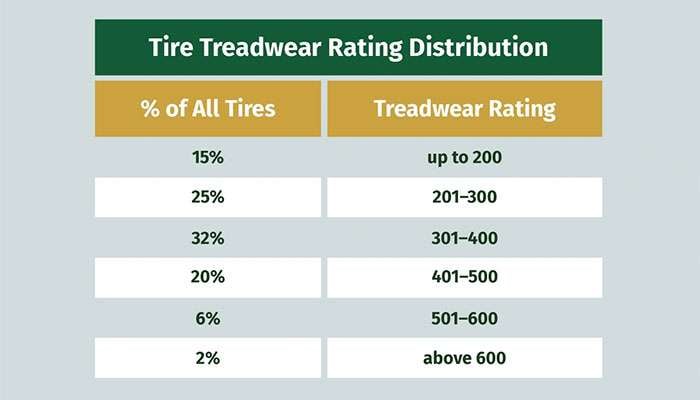
Image Source: Wonderland Tire
Understanding the true cost of tire ownership requires looking beyond initial purchase prices. Real-world durability and performance ratings tell a different story than warranty claims alone.
Both tires carry identical UTQG treadwear ratings of 840, suggesting comparable durability expectations. However, the Continental TrueContact Tour earns superior A/A grades for traction and temperature resistance compared to the Michelin Defender 2's B/B ratings. These higher performance grades indicate the Continental maintains better grip characteristics and heat resistance throughout its service life.
Each manufacturer provides identical 80,000-mile treadwear warranties, showing confidence in their respective designs. From a warranty standpoint, neither tire offers an advantage over the other.
When examining the popular 215/55R17 size, pricing reveals a $27 gap between options. The Michelin Defender 2 costs $207 while the Continental TrueContact Tour runs $180. This 15% premium for the Michelin must be evaluated against long-term performance differences.
The most significant factor emerges in actual wear testing. The Michelin Defender 2 achieves an expected 94,400 miles compared to just 59,400 miles for the Continental. This 58% durability advantage changes the value equation completely, potentially saving approximately $200 over the tire's lifespan.
When you consider replacement frequency, the Michelin's higher initial cost becomes an investment in fewer tire changes. The Continental may cost less upfront, but its shorter lifespan means more frequent replacements and higher long-term expenses.
For complete specifications and current pricing on both options, check Performance Plus Tire's Continental TrueContact Tour page or their Michelin Defender 2 page to make the best decision for your specific driving needs and budget.
The following table presents all key performance metrics and specifications side-by-side for easy comparison. These results come from extensive testing across multiple conditions to help you evaluate which tire matches your specific needs.
| Feature | Michelin Defender 2 | Continental TrueContact Tour |
|---|---|---|
| Price | $159 | $140 |
| Warranty | 80,000 miles | 80,000 miles |
| Expected Real-World Mileage | 94,400 miles | 59,400 miles |
| UTQG Rating | 840 B/B | 840 A/A |
| Wet Performance | ||
| - Wet Braking Distance (60-0 mph) | 156 ft | 153 ft |
| - Wet Handling Lap Time | 35.35s | 34.11s |
| - Subjective Wet Grip Score | 5.82/10 | 6.47/10 |
| Dry Performance | ||
| - Dry Braking Distance (60-0 mph) | 129 ft | 129 ft |
| - Subjective Dry Handling Score | 6.53/10 | 6.32/10 |
| Winter Performance | ||
| - Snow Braking (25-0 mph) | 84.5 ft | 73.4 ft |
| - Snow Acceleration (0-12 mph) | 36.4 ft | 31.5 ft |
| - Ice Braking | 55.0 ft | 53.2 ft |
| - Ice Acceleration (60 ft) | 6.17s | 5.99s |
| Comfort | ||
| - Ride Comfort Rating | 7.5/10 | 7.75/10 |
| - Steering Character | More eager, immediate response | Light and direct |
Our testing reveals two distinct tire personalities that serve different driver priorities. The Continental TrueContact Tour dominates safety-critical situations, stopping shorter on wet roads and providing superior traction in snow and ice conditions. It also delivers a more comfortable, quieter ride that reduces fatigue during long drives.
The Michelin Defender 2 excels in long-term value with its exceptional 94,400-mile projected lifespan. This durability advantage means fewer tire replacements and significant cost savings over time, despite the higher initial purchase price. Both tires perform virtually identically in dry conditions, making weather performance and longevity the key differentiators.
Your choice depends on your specific driving environment and priorities. Drivers who frequently encounter wet weather, snow, or prioritize ride comfort should consider the Continental TrueContact Tour. High-mileage drivers or those seeking maximum long-term value will find the Michelin Defender 2 delivers exceptional returns on investment.
The $19 price difference becomes less significant when considering real-world performance differences. Continental's superior wet and winter safety could prevent accidents, while Michelin's longevity advantage potentially saves hundreds of dollars in replacement costs.
For detailed specifications on either option, check out the Continental TrueContact Tour and Michelin Defender 2 pages to make an informed decision based on your specific needs.
Both represent quality choices from respected manufacturers. The performance differences we've documented show how touring tires with similar positioning can deliver markedly different experiences when tested thoroughly. Choose based on whether you prioritize immediate safety benefits or long-term value – either decision represents a smart investment in your vehicle's performance.
These comprehensive test results reveal distinct performance profiles that should guide your tire selection based on your specific driving needs and priorities.
• Continental dominates winter safety: Stops 11.1 feet shorter in snow and 3 feet shorter on wet roads, making it the clear choice for challenging weather conditions.
• Michelin delivers exceptional longevity: Expected 94,400 miles vs Continental's 59,400 miles—a 58% advantage that potentially saves $200+ over tire lifetime despite higher upfront cost.
• Dry performance is virtually identical: Both tires stop in exactly 129 feet from 60 mph, with only minor handling differences that won't impact most drivers.
• Price vs value equation favors different priorities: Continental costs $27 less initially but Michelin's superior durability makes it more economical long-term for high-mileage drivers.
• Comfort characteristics differ subtly: Continental offers a more relaxed, quieter ride (7.75/10) while Michelin provides firmer, more connected steering feel (7.5/10).
The choice ultimately depends on whether you prioritize immediate weather performance and comfort (Continental) or long-term value and durability (Michelin). Both represent quality investments from respected manufacturers, each excelling in different areas that matter most to specific driver profiles.
The Continental TrueContact Tour outperforms the Michelin Defender 2 in wet and winter conditions. It stops 3 feet shorter on wet roads and 11.1 feet shorter in snow, providing superior traction and safety in challenging weather.
The Michelin Defender 2 demonstrates exceptional longevity, with an expected real-world mileage of 94,400 miles compared to the Continental TrueContact Tour's 59,400 miles. This represents a 58% advantage in wear for the Michelin.
The Continental TrueContact Tour edges out slightly in comfort, scoring 7.75/10 compared to the Michelin Defender 2's 7.5/10. The Continental is noted for its quieter operation, while the Michelin offers a firmer, more responsive ride.
Yes, there is a price difference. The Michelin Defender 2 typically costs about $207, while the Continental TrueContact Tour is priced around $180, representing a $27 or 15% premium for the Michelin option.
Both tires demonstrate nearly identical performance in dry conditions. They have the same dry braking distance of 129 feet from 60 mph, with only minor differences in handling characteristics that most drivers won't notice in everyday use.